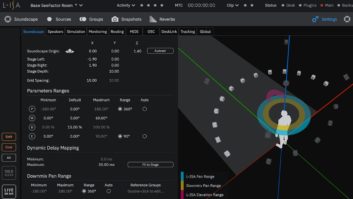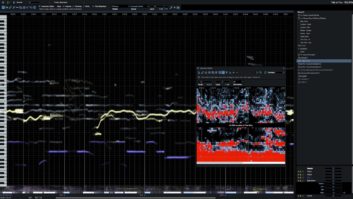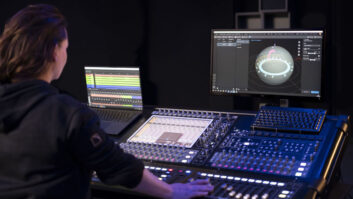
Edmeston, NY – May 6, 2015 – Reuven Amiel is a unique mix engineer who has come full circle from analog consoles and tape, to mixing only digitally in-the-box, to his studio today which combines the best of both worlds, a hybrid analog-digital setup, with a software DAW and plug-ins, analog summing, and integrated outboard gear. “If you are looking for flexibility, the Dangerous Music products give you freedom,” states Amiel unequivocally. “I don’t feel like a slave to a certain sound when I am mixing with Dangerous gear. I am not kidnapped by the sound of my summing or my compressor or my EQ. If I want color, I have the freedom to color the sounds in the way I want with other gear. That’s very important for me.” Amiel is working in his Miami, Florida-based studio with his ‘Hybrid’ setup featuring the Dangerous Music 2-Bus summing, Monitor ST monitoring and switching combined with the new Convert-2 DAC, the BAX EQ and the Dangerous Compressor.
It’s All In The DAC
Amiel is also testing the upcoming Dangerous Convert-2 and Convert-8 DACs, and is very impressed, “I have tested and A/B’d many converters and the Dangerous Convert-8 is the only memorable, striking experience I have had-not only for the quality, musicality and richness of the converter-but for the way the Convert-8 makes the music feel right,” he says. “Having such a pure, clean sound with so much headroom gives me this feeling of freedom to color and shape my stems in any way I want,” he adds about the new DAC. “I can use analog gear or plug-ins to vary some tones, while feeling confident that the integrity of the overall sound is being maintained by the Convert-8.”
He recalls first using the new Dangerous Convert-8 DAC and how it changed his perceptions, “I was mixing a very complex song that I had been working on for a long time, but the tracks weren’t recorded that well. I put the tracks through the Convert-8, and when I pressed play the song just immediately felt right. It just made me feel so happy!-the sound came through with more richness, and it felt more real and natural. I feel like I bypassed hours of work by just plugging in the Convert!”
Describing some specifics about the new Convert DAC, Amiel says, “The top end sounds more natural, you don’t have the kind of harshness that you sometimes get with other high-end converters, and the low end just sounds tighter and bigger than other converters I have used. With the new Dangerous Music converter I found my mix had more richness, and was more articulate.”
To Compress or Not to Compress
“The Dangerous Compressor highlights a lot of the melodic elements of the mix in a way that just lets them sparkle. It’s so clean, but it has a certain vibe that is just so gorgeous,” states Amiel, describing his sense of the Dangerous Compressor on his mixes. “I put the Dangerous Compressor on after everything and the mix starts to sound ‘together’ – I put it on near the end of my mixing process, not necessarily mixing through it from the beginning,” reveals Amiel. “I just put on the Compressor to create the final vibe, to glue things a little bit more together, and sometimes to give a different motion or movement in the mix.”
“I use a lot of other compressors that give me different types of character, and part of their sound is based on taming the top end. In that regard, the Dangerous Compressor kind of does the opposite: I don’t feel it really touches my top end in the way other compressors do where the transients get lost! It’s not changing the balance of my top end, not making it mushy or blurry, but it does give me something in the high-mids, it helps the focus of my mix. At the end of the day the Dangerous Compressor opens up the top end, makes it more exciting and gives a euphoric sound, which is both subtle and complex,” he adds.
The Dangerous Compressor has many manual adjustments and choices but also some automatic settings, “I love the Smart Dynamics, I think it’s great!” he says. “I have it engaged all the time! (laughs) And I like the ‘soft-knee’ depending on what I want to do, but I sometimes just use the automatic attack and release. That’s a big deal for me because I am always concerned an automatic setting is going to create side effects in the mix; on other compressors I have preferred to just dial in the right release and the right attack for the instrument or the whole mix. To be able to choose automatic on the Dangerous Compressor for me makes me say: ‘Wow! They really nailed it!’ It sounds great. I trust the automatic settings from Dangerous.”
Summing and All That Analog
“Before digital, I always used analog consoles-in the studio and touring live,” states Amiel. “When the digital revolution came along I never complained, I just had to adapt and use what was there. I never put a barrier between analog and digital. I am not attached to the ‘analog sound’ just what sounds better, what is best for different applications. I compared a lot of summing boxes, but when I tried the Dangerous 2-Bus I totally fell in love. Sound is what matters,” says Amiel. “I felt that everything was wide open, I love the low end, it’s very unique the way the low end flows -amazing. The stereo image is wider on the 2-Bus too. Over the years I would sometimes try out other summing boxes to see what happened, but always came back to the 2-Bus. It’s also very reliable, that’s important to me, when I check my mix calibration I always check the 2-Bus and it’s always rock solid.”
He continues, “I had been working exclusively in-the-box for so many years, no analog chain at all, but I didn’t feel shocked when I came back to analog using the 2-Bus summing -it was just like mixing with an analog console. The combination of a hybrid system, plug-ins and analog hardware inserts, and the Dangerous 2-Bus summing, sounds as good as an analog console, and if there is a difference it is so small that it really depends more on the skills of the engineer than the technology. What I love about a digital software and analog hardware system is the recall-ability of having so many channel strips in the DAW, and so many other settings that I don’t have to check on when I recall a mix, that’s really the part where I realized ‘Wow, I really like THAT about the hybrid system!'”
BAX EQ: Color Done Right
Amiel recalls first listening to the Dangerous BAX EQ, “I had many different EQs in the past six years, I really like all of them, but I remember when I heard the BAX EQ for the first time it sounded very natural, and it had very broad strokes,” he recalls hearing the Dangerous EQ at a trade show. Eventually he got to try it first-hand. “So when I got the BAX EQ in my studio and I had a mix going through another one of my EQs with 6 bands, I took it off and put on the BAX, and ‘Boom!’ it had a great sound right away, and, I thought: ‘This is something that I’m looking for!’ I loved the BAX instantly and for me it sounded better than the other EQ.”
Questioning what exactly is going on inside the BAX EQ, Amiel asks, “The striking part to me is, ‘How can two bands on the BAX EQ enhance the sound in a way that sounds better than on my other EQ that had 6 frequency bands?’ It made the spectrum as full as it was with the previous EQ, and sounds even better-on the BAX I was boosting one point in the high frequency and another in the low end, I said to myself, ‘Wow! This EQ is really something great.’ And the BAX is not harsh, I am very sensitive to harshness, I am always aware of that. The BAX EQ really sounds amazing, and I love the simplicity,” adds Amiel.
Monitoring & Multiple Mixes
Although he uses a Dangerous Monitor ST with the new Convert-2 DAC now, Amiel took a few pieces of gear to get there, “Over the last 6 years I had a basic monitor system, inexpensive but useful, then I changed to a very high-end monitor system, everybody raved about it, but I was always intrigued by the Monitor ST. Then I got to try the ST in my studio and I found that everything sounded cleaner, and the bass was tighter, and I had a very different picture of my stereo image, I said, ‘Wow this is crazy!’ I could hear more top end in a very natural way-I heard all kinds of high and high-mid information that I didn’t hear before.”
For Amiel, beyond the sound, the Monitor ST hardware controller and its capabilities are very important too, “I love the remote control too, professionally, having all the options for different speakers, calibration for the speakers and inputs, the routing you can do with it- and the quality of the sound. And the fact that when I am mixing at really low volumes I still have the whole balance, I don’t lose low end, like you do with many other monitor systems. I can’t live without the Dangerous Monitor ST and Convert-2,” concludes Amiel.
With the Dangerous Convert-2 component combined with the Monitor ST, Amiel can have multiple inputs for comparing mixes, “With my converters I have two extra outputs for reference so I can put different mixes on them and access them with a single button on the ST remote. So if I am mixing a record and I already mixed a song that sounds great, and I’m mixing a new song, I can put the previous mix in the session and just touching one button I can A-B the new mix with the previous mix to have more continuity. Besides the practicality to having these A-B options, I can have a second mix from someone else’s album and challenge my mix-that’s amazing.”
Dangerously Simple
Wrapping up about his sense of Dangerous Music gear and his hybrid studio, Amiel concludes, “Talking about simplicity, that’s something that’s very remarkable about Dangerous Music. A lot of people like gear that gives you a lot of options, a lot of knobs, and I understand that. I love that when I use instruments like a synthesizer or a soft synth that has a lot of knobs where you can tweak the sounds. But in audio, I rather prefer to have it simple, few knobs, few controls. I just want the equipment to sound great. With that, I am not saying the Dangerous products are not flexible or limited, actually the opposite,” he says “For example when I am using the BAX EQ, it is very subtle what it’s doing to my mix, but it’s simple in a very sophisticated way. It’s hard to find this complex, subtle sound in another piece of gear. This is what I love about Dangerous, I don’t care about having a hundred knobs, I care about this very sophisticated sound I get. I leave all the complexity and all the possibilities in the circuits that make the gear do this to the Dangerous Music product designers! This gives me the freedom to just move a couple of knobs and say: ‘Wow, it’s sounding great!'”
About Mix Engineer Reuven Amiel
Grammy Winner Reuven “Paquirri” Amiel is one eclectic and versatile Mixing Engineer/Producer. He applies his modern, edgy and vibe-y sound to Modern Rock, Electro-Pop, as well as Latin Pop, moving through World Music, and all styles in between.
He has worked with a kaleidoscope of artists and genres, having lived in many hemispheres of the world. From his beginnings, studying under the wings of Yoav Gera (Ofra Haza, Yehudit Ravitz) and traveling to get knowledge from top producer Bob Ezrin (Pink Floyd, Peter Gabriel, Kiss), to working with Israeli/Scottish underground rock band Mushroom Symphony. He has also worked with top Latin Grammy-winners and nominees such as Ricardo Arjona, Shaila Durcal, Gian Marco, Susana Baca, and Cristian Castro, among many others. In 2013 he received a Latin Grammy for mixing recording artist Felipe Pelaez.
Upcoming projects for Amiel in 2015 include American artist Rachel London, Canadian electro band NOIA, Italian pop rocker Silvia Lorusso, Latin artist Patricia Loaiza, and producing and mixing for the European rock band, Pony Asteroid.
Visit Reuven Amiel’s website at: http://amielmix.com
About Dangerous Music
Dangerous Music, Inc. designs and builds award-winning hardware products that are indispensable to any DAW-based recording, mixing or mastering environment. The Company pioneered the concept of the dedicated analog summing buss for digital audio workstations with the Dangerous 2-Bus in 2001. Today, Dangerous Music offers a wide range of products for recording, mastering, mixing and post-production facilities, all designed and built with mastering-quality standards and a practical aesthetic. Key products include the Dangerous 2-Bus and 2-Bus LT, Dangerous Monitor ST-SR, Dangerous D-Box, Dangerous Master, Dangerous Liaison, Dangerous Monitor, Dangerous Source, Dangerous BAX EQ, and the Dangerous Compressor.
For more information on Dangerous Music visit http://www.dangerousmusic.com phone 845-202-5100 or email: [email protected]
All trademarks are the property of their respective holders. Description and specifications are subject to change without notice.







